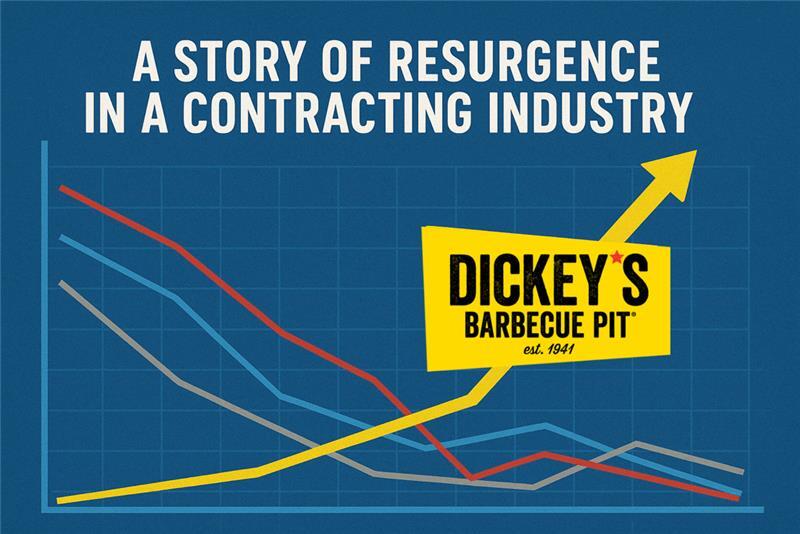
Dickey’s Barbecue Pit: A Story of Resurgence in a Contracting Industry
While many of the restaurant industry’s most recognizable names have spent the last five years in retreat, Dickey’s Barbecue Pit has reversed this course and is once again on a path of growth. This turnaround is a notable exception in a landscape littered with closures and bankruptcies.
Widespread Restaurant Closures and Bankruptcies
Many restaurant chains and franchisees have recently announced major closures, often as a result of bankruptcy filings or strategic efforts to downsize underperforming locations.
- Red Lobster: Filed for Chapter 11 bankruptcy in March 2025, which led to the closure of over 100 locations across the S.
- TGI Fridays: Filed for Chapter 11 bankruptcy in November 2024, closing 134 locations to address legacy liabilities and position the company for a new
- Subway: Has been experiencing a long-term decline, with a net loss of over 600 locations in 2024 alone, as it works to modernize its remaining
- Wendy’s: Closed 140 underperforming restaurants in 2024 but aims to offset these closures by opening hundreds of new
- Denny’s: Announced plans to close up to 150 locations in 2024 and 2025 as part of a strategy to improve profitability by shuttering low-volume
- Hooters: Abruptly closed nearly 40 locations in June 2025 following a Chapter 11 bankruptcy filing, with plans to transition to a franchise-only model
- Boston Market: Has faced one of the most drastic declines, closing over G0% of its locations in the last two years and facing multiple lawsuits for unpaid
- Jenkins Barbecue: Has closed all locations in 2025, after 70 years in business in the Florida market
- Smokey Bones: Has closed 15 locations in 2025, over 89% of its total locations
- Sticky Fingers Rib House: Has closed 82% of its locations in 2020 and filed for bankruptcy in 2025
- Armadillo Willy’s a Bay Area: After 42 years in business, the BBQ chain abruptly closed all of its locations in an unexpected move in
- Chris s Pitt’s served the Los Angeles area for over 70 years, growing to over a dozen locations but as of 2025, only two locations remain
- Bobby Rubino’s: A New York-to-Florida BBQ chain that opened in the 1980s and once peaked at 25 locations shuttered all its remaining restaurants in
Dickey’s BBQ Pit’s Bounce Back
These national chain restaurants and the barbecue specific regional chains are still navigating financial turbulence and shuttering locations; in contrast Dickey’s Barbecue Pit has shown a remarkable rebound in 2025.
In 2024, Dickey’s barbecue closed just over 80 locations, an unusual occurrence for the nation’s largest barbecue chain that has been continuously operating and expanding since 1941. This unit reduction represented about a 16% reduction in size, for the Texas based Barbecue franchise.
These closures, while widely reported, were often presented in isolation, missing the critical context that the entire restaurant industry was facing a wave of contraction. Like other major chains, Dickey’s was forced to make tough but necessary decisions to shed underperforming locations and stabilize its business for the long term.
However, Dickey’s implemented a strategic “forward momentum” plan for 2025. The company announced it has opened 46 new locations from January through August 2025 and is on pace to surpass 60 new openings by the end of the year. This growth is part of a plan to retain its position as the world’s largest barbecue franchise by an ever widening margin by focusing on franchise profitability, technological enhancements, and new menu offerings. The company’s store count is projected to again exceed 400 locations worldwide, putting it on a solid path to rebounded growth, a stark contrast to the continuing contraction seen at many of its competitors, and the restaurant industry at large.
The Dickey’s Franchise Difference
Dickey’s has bucked negative industry trends and media narratives. For too long, news coverage fixated on the brand’s closures in a vacuum, without the crucial context of a widespread industry-wide crisis. This tunnel-vision reporting created a misleading double standard, painting a picture of decline for Dickey’s while often glossing over or treating similar, or even more severe, setbacks at other chains as strategic re- alignment. The reality is that Dickey’s closures were part of a difficult but necessary process to right the ship; a process many of its competitors are still struggling to complete.
Following a year long period of challenges, the company strategically prioritized food quality and guest satisfaction while also focusing on franchisee profitability. This focus on a sustainable business model for its operators combined with superior guest value has been instrumental in building a foundation for a new era of expansion in the ever evolving restaurant landscape.
This year, the brand is on pace to open over 60 new locations, pushing its worldwide store count past 400. This milestone makes Dickey’s store-count positive for the year, a remarkable feat when so many competitors are still in a state of contraction. It’s a clear signal that the legacy brand is not just stabile but is on a strong upward trajectory. The company’s success demonstrates that with the right strategic adjustments and a focus on core business fundamentals, it is possible to not only survive but to thrive in today’s demanding market.